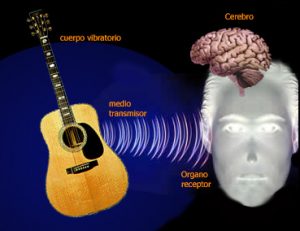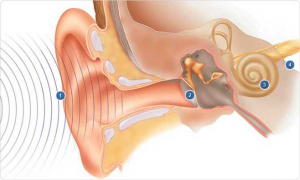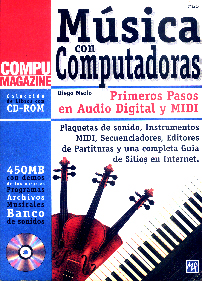
 ♦ Acoustics│It would be truly absurd to delve into music technology without taking a brief look at some elementary acoustics principles. The sound is our raw material of work, not knowing it is a mistake that we will pay dearly when we face any digital audio manipulation program.seriously know acoustics is the driver’s license that we will require any serious work to not crash at the first curve computer. The elements of sound science would fill the entire space of this article, so we will only limit ourselves to “cleaning up” some concepts. The rest of the work, as always, is left to you….
♦ Acoustics│It would be truly absurd to delve into music technology without taking a brief look at some elementary acoustics principles. The sound is our raw material of work, not knowing it is a mistake that we will pay dearly when we face any digital audio manipulation program.seriously know acoustics is the driver’s license that we will require any serious work to not crash at the first curve computer. The elements of sound science would fill the entire space of this article, so we will only limit ourselves to “cleaning up” some concepts. The rest of the work, as always, is left to you….
The sound phenomenon:
 What we hear is largely the result of a series of energy conversions. This concept, coupled with the need to perpetuate information, is what drove hi-fi researchers to develop and perfect their equipment. Sound research is absolutely related to the physiology of the auditory apparatus. In reality, if we did not have ears, the sensation of “sound” would be imperceptible to us. For this sensation to exist, certain conditions are required:
What we hear is largely the result of a series of energy conversions. This concept, coupled with the need to perpetuate information, is what drove hi-fi researchers to develop and perfect their equipment. Sound research is absolutely related to the physiology of the auditory apparatus. In reality, if we did not have ears, the sensation of “sound” would be imperceptible to us. For this sensation to exist, certain conditions are required:
- Vibrating Body
An elastic body that causes (or allows to cause on it) the original vibration. Elastic, because it will tend to return to its equilibrium molecular position after having been subjected to some perturbation. Vibrating bodies are tensioned ropes, columns of air enclosed within a tube, membranes, hollow concave bodies enclosing a volume of air, metal plates of a certain flexibility, and a host of other materials.
- Transmission medium
An elastic gaseous, liquid or solid medium that interacts with the vibrating body and acts as a scattering field for the generated wave.
- A receiving organ
The auditory apparatus behaves as a wave transformer, and performs a series of marvelous energy conversions that will eventually be transformed into the neurological impulse that will reach the brain via the auditory nerve.
- A brain
The brain is where the complete decoding actually takes place, transforming the electrical impulse into a psychological sensation that we know as “SOUND”.

Let’s imagine that we tighten a rope between two points. We have a potential vibrating body. As soon as we break its equilibrium state, it will begin to vibrate, causing small pressure changes in the surrounding medium.
These moments of pressure and decompression will be transmitted to the air molecules surrounding our system. The air particles, being an elastic medium, will vibrate along with our string, creating a chain reaction that will be transmitted by inertia to the immediately adjacent particles, and so on.
The linear velocity of this dispersion is what we call the speed of sound (approximately 345 meters per second in air and depending on the temperature).
The sound wave propagates in all directions and can, depending on the original sound source and the medium, adopt different wavefront shapes. Let us clarify that the air particles do not move, they only vibrate transmitting their energy to the following ones. (The example of the stone in the lake is confusing if we do not take the precaution of also observing what happens with an object floating in the lake. The body will not move, it will only vibrate in the same place).
That vibration reaches our eardrums, which vibrate accordingly, transmitting that vibration to the inner ear. In the inner ear the transmission medium is now a liquid.
The vibrations of the inner ear fluid are captured by small hairs or cilia, and through a small physiological organ (organ of Corti) that energy will be transformed into an electrical impulse and communicated to the brain where the sound sensation is perceived.
The following videos are a MUST, if we want to take the time to understand in DEPTH the sound phenomenon:
▼
▼


In Depth:
Hearing aid conversions:
1-
The penetration of the sound wave first reaches the external ear. The disturbance consists of small, subtle changes in air pressure above atmospheric pressure. The sound undergoes a series of pressure reinforcements or attenuations due to the reflection of the wave in the acoustic environment in the first place and on the walls of the pinna. In this way it penetrates the eardrum. 2- The eardrum is a 0.1 mm thick membrane that is excited by sound pressure. Due to its curious physical properties, the eardrum adds or masks several harmonics that color the sound sensation. In contact with the eardrum we find the ossicles system (hammer, anvil and stirrup). The outer end of the ossicles chain is in contact with the eardrum, while the inner end communicates with the inner ear thanks to the oval window. Two types of elements are thus connected: Air and liquid. The vibration transmission uses from now on a liquid medium. 3- This vibration will reach the cochlea (snail). In the cochlea we find the basilar membrane. The basilar membrane borders the cochlea and has about 24,000 transverse fibers and about 1,400 neurons. It is responsible for acoustic detection. And it relates to frequency decoding. (the human ear understands frequencies ranging from 20 Hz to 22,000 Hz).
4-
Above the basilar membrane is the organ of Corti. (consisting of about 10,000 hair cells) is responsible for generating the nerve impulse, establishing a new energy conversion. (from fluid vibration to electric potential changes). The signal reaches the brain, which completes the interpretation process by obtaining the sensation of Sound..
In the following example we can see in super slow motion
how the movement of a string evolves when it is plucked, decaying due to friction:
The sound phenomenon will no longer be perceived due to three important factors:
- Distance:
As the blast wave moves away from the original sound source, it loses energy, due to the mass resistance of the molecules of the medium itself, in addition to the absorption of the vibration by non-elastic media, and interference from other pressure waves.
- Rest of the vibrating body: If the movement of the vibrating body is suddenly damped (we stop the string with our hand) the sound ceases. If, on the other hand, excitation persists, the sound will continue until then. One factor that causes vibrating bodies to stop is mass. When we leave the string vibrating until the sound ends on its own, what is stopping the persistence of the phenomenon is the mass itself playing a battle of equilibrium between inertia and the force of gravity.
- Temporary or complete damage to the receiving organ: It seems absurd to talk about it, but it is necessary to point it out once and a thousand times. Hearing aid care is much more important than any hi-fi equipment. Excessive sound pressure causes the eardrum to rupture, the symptom is a small hemorrhage in the ear. This can lead to partial or complete deafness depending on the intensity. Even if the tympanic membrane does not tear, subjecting it to frequent high sonic pressures causes it to lose more and more elasticity (the human body defends itself…) leading to hearing loss.
If none of the first two causes stopped the sound phenomenon, we could listen to what a neighbor talks twenty blocks away from home, in the first case, and we would go crazy because of the infinite amount of sounds we would have to tolerate in the second.
And here you can see a violin, when the bow rubs the string in slow motion:
Sound reflection and absorption:
Although this topic deserves a separate article (and we will!). Here are some very basic concepts. The propagation of the sound wave undergoes on its way through the medium, a phenomenon of reflection and absorption (and we will also take into account refraction). That is, it bounces (reflection) against certain surfaces (marble, glass, walls, etc.), is deflected in its trajectory by certain structures (refraction) and is damped (absorption) by other materials (carpets, curtains, mattresses, etc.).
The reflection phenomenon is known as reverberation (Reverb). When the times at which the reflection reaches us are close to the times at which we receive the original wave, we speak of reverb, when they are greater we begin to perceive them as echoes (Delay or Echo). If an environment has many absorbent surfaces we say that the environment is “dry”; if it has many reflections we say that it is “wet”.
A loudspeaker with music produces vibratory movements as well:
 Organology, which is the science that studies musical instruments, establishes for its principle of classification, that an instrument will be CORDOPHONE, AEROPHONE, IDIOPHONE or MEMBRANOPHONE, according to whether the vibrating body is respectively: a string, an enclosed air column, a percussive elastic body other than a membrane, and a percussive elastic body of the membrane type.
Organology, which is the science that studies musical instruments, establishes for its principle of classification, that an instrument will be CORDOPHONE, AEROPHONE, IDIOPHONE or MEMBRANOPHONE, according to whether the vibrating body is respectively: a string, an enclosed air column, a percussive elastic body other than a membrane, and a percussive elastic body of the membrane type.
To be continued: In the next articles we will talk about the characteristics of sound and the sound parameters: Pitch, Intensity, Duration and Timbre.
 This article has passed the verifications of the Audiomidilab Academic Council, and is therefore certified by specialists in the field. This means that it is formally correct and proves to be a reliable source of information.. Every article written by an author or submitted by a correspondent or contributor undergoes this rigorous certification system.
This article has passed the verifications of the Audiomidilab Academic Council, and is therefore certified by specialists in the field. This means that it is formally correct and proves to be a reliable source of information.. Every article written by an author or submitted by a correspondent or contributor undergoes this rigorous certification system.


©2004 Audiomidilab.com. Source: Book “Música con computadoras” Diego Merlo – ISBN 987-9131-31-2. Used with express authorization of the author. All rights reserved. The publisher may have included audiovisual content in external links that correspond to third parties. Invoking the right to quote for educational purposes.


